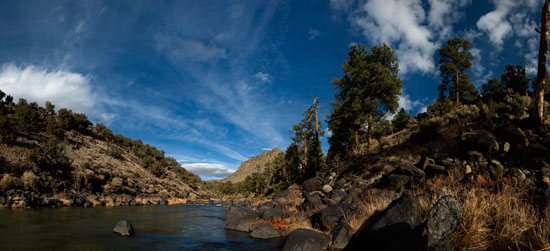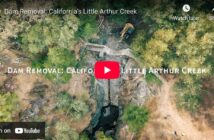
Rio Grande del Norte – Our Newest National Monument
Photo: Josh Duplechian
From TU:
Washington D.C. — After years of collaboration, the Rio Grande del Norte, a place close to New Mexican sportsmen’s hearts, will be protected as a national monument.
The monument was designated by President Barack Obama at the request of a diverse group of local interests. The Rio is located near Taos, New Mexico and is known best by anglers for it’s thriving population of wild German brown, cuttbow and native Rio Grande cutthroat trout.
“We are excited to see a place as special as the Rio Grande del Norte be protected for generations to come,” said Chris Wood, CEO of Trout Unlimited. “Protection of the Rio has been years in the making, and for the hunters and anglers of New Mexico, this is a huge victory. They have worked very hard to preserve the amazing fishery and hunting opportunities that exist in this unique place and we should celebrate that in a big way.”
This designation will protect more than 60 miles of trout stream and critical habitat for game such as pronghorn, mule deer, migratory waterfowl, bighorn sheep, turkey and elk.
“So often we look at conservation through the lens of loss,” Wood said. “But not today. Today is about love for a place special enough to unite some of the most competitive of interests in an effort to protect something that means so much to so many.”
This effort came not from the top down as many might expect with a monument designation, but from the ground up – directly from hunters, anglers and the many other traditional land users who value this place.
Efforts to protect the Rio have been underway for years in the form of a National Conservation Area, to little avail. While bi-partisan, user supported legislative action was the preferred route for organizations like Trout Unlimited, the vehicle of conservation was not necessarily important in this instance – only that sportsmen be able to keep such a special place exactly as it is today.
There are few places like the Rio. With a spectacular wild fishery, game throughout and towering walls rimming the gorge, it is, without doubt worthy of todays designation says Mark Casias, a big game outfitter based in Taos.
“My family has been hunting and fishing these lands for eleven generations,” Casias said. “This land sustains us. It supplies meat for our families and firewood to heat our homes in the winter. The National Monument designation protects more than just habitat, wildlife and fish – it protects the very future of our traditional land-based culture.”
Matching these ecological and scenic resources, the area boasts more than 10,000 years of human history, much of which echos the importance of the hunting heritage still present. Today, all these species – save for bighorns – are still actively pursued by sportsmen throughout the Rio Grande del Norte region. The local bighorn population is quickly expanding and sportsmen hope to soon be able to also peruse this majestic in the Rio Grande del Norte as well.
This section of the Rio Grande River is also arguably New Mexico’s most iconic and expansive wild trout fishery. Together, the hunting and angling opportunities of the Rio Grande del Norte contribute tens of millions of dollars to New Mexico’s economy annually, dollars people like Nick Streit, Taos Fly Shop Owner, and President of the Enchanted Circle Chapter of Trout Unlimited rely on.
“The National Monument designation of Rio Grande del Norte will ensure that local business owners like myself – who rely on the long term health and viability of our public lands and watersheds – will have access to quality resources we can count on to sustain our economic endeavors,” Streit said. “This too is about my children. This designation will ensure that they will have the same amazing public lands hunting and fishing opportunities I’ve enjoyed my entire life. This is the very essence of our northern New Mexico outdoor lifestyle…”
###
Trout Unlimited is the nation’s oldest and largest coldwater fisheries conservation organization. It has over 140,000 members dedicated to conserving, protecting and restoring North America’s trout and salmon fisheries and their watersheds.




3 Comments
Only possible Wild populations of German Brown’s I know of are in Europe…US Browns are introduced (since like the late 1800’s?)…NOT wild, hatchery fish , even invasive according to some…which makes me favor (and worry about) the RGCT’s 13 core populations…
…but Chris knew this…right?
I am available for Research…and proof reading
Hey J, Wow, you make a statement like that, yet you don’t know the difference between wild and native fish? Am I incorrect that a wild fish is one that was born and raised in the river? Those browns are just that. They are not native, but they are wild. You have made your ignorance apparent to all, so you probably won’t get any calls to do research or proof reading. I don’t agree with everything TU does, but protection of such a place is something to be celebrated. You sound like you have it in for Chris Wood. Let me tell you something . . . the river and the trout don’t care about your politics.
Hey Steve,
Yes, Mr. J mispoke, and you are quite correct that in customary angler language at least, those browns are wild, not hatchery trout. But don’t forget that their ancestors did come from a hatchery, and they have had a negative impact on the native cutthroats, which we can assume is what J. meant when he spoke in favor of “the RGCT’s core populations.”
But where does your crack about politics come from? J. makes no political points at all, he merely speaks for the native fish, and I certainly applaud that sentiment. But we can deduce a little from what you say; “I don’t agree with everything TU does” hints at a belief that TU should stick to providing great fishing for wild trout, even if they arrived in the last century, rather than removing them to bring back native fish.
Perhaps you think that global warming isn’t a real issue, it’s been really exaggerated? Never mind, you’ll know far sooner than any of us will like.
BUT; Bravo, yes; “protection of such a place is something to be celebrated” you are quite right. Let’s leave it to professionals now to decide what elements of the ecosystem belong there, and what animals and plants are invasive and need to go, even if it’s those wild brown trout. I will certainly come every summer to visit a river that harbors nothing but those beautiful Rio Grande Cutthroats!